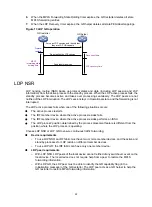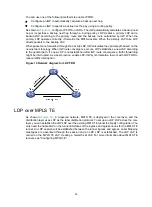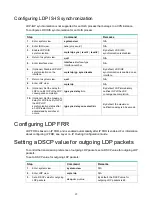
29
Step Command
Remarks
5.
Set the Keepalive interval.
mpls ldp timer
keepalive-interval
interval
By default, the Keepalive
interval is 15 seconds.
6.
Configure the LDP transport
address.
mpls ldp transport-address
ipv6-address
By default, the LDP IPv6
transport address is not
configured.
Configuring LDP backoff
If LDP session parameters (for example, the label advertisement mode) are incompatible, two LDP
peers cannot establish a session, and they will keep negotiating with each other.
The LDP backoff mechanism can mitigate this problem by using an initial delay timer and a maximum
delay timer. After failing to establish a session to a peer LSR for the first time, LDP does not start an
attempt until the initial delay timer expires. If the session setup fails again, LDP waits for two times
the initial delay before the next attempt, and so forth until the maximum delay time is reached. After
that, the maximum delay time will always take effect.
To configure LDP backoff:
Step Command
Remarks
1.
Enter system view.
system-view
N/A
2.
Enter LDP view or enter
LDP-VPN instance view.
•
Enter LDP view:
mpls ldp
•
Enter LDP-VPN instance
view:
a. mpls ldp
b. vpn-instance
vpn-instance-name
N/A
3.
Set the initial delay time and
maximum delay time.
backoff
initial
initial-time
maximum
maximum-time
By default, the initial delay time is
15 seconds, and the maximum
delay time is 120 seconds.
Configuring LDP MD5 authentication
To improve security for LDP sessions, you can configure MD5 authentication for the underlying TCP
connections to check the integrity of LDP messages.
For two LDP peers to establish an LDP session successfully, make sure the LDP MD5 authentication
configurations on the LDP peers are consistent.
To configure LDP MD5 authentication:
Step Command Remarks
1.
Enter system view.
system-view
N/A
2.
Enter LDP view or enter
LDP-VPN instance view.
•
Enter LDP view:
mpls ldp
•
Enter LDP-VPN instance view:
a. mpls ldp
b. vpn-instance
vpn-instance-name
N/A
















































